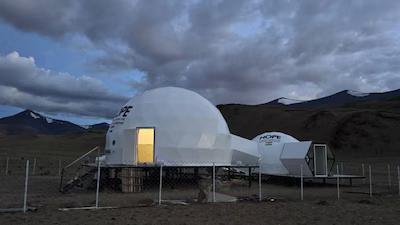
ISRO sets up station in Ladakh to simulate life on Moon & Mars
In a groundbreaking move, the Indian Space Research Organisation (ISRO) has set up a unique station in Ladakh’s Tso Kar Valley, dubbed the Himalayan Outpost for Planetary Exploration (HOPE). This ambitious project aims to simulate life on the Moon and Mars, and it’s all set to kick off with a 10-day simulation mission starting August 1. The valley, chosen for its extreme conditions, will help scientists test life-support systems for future lunar and Martian missions.
Located at an altitude of 15,000 feet, the Tso Kar Valley is an ideal location to mimic the harsh environments of the Moon and Mars. The valley receives high UV radiation, has low atmospheric pressure, extreme cold temperatures, and saline permafrost, which are similar to the conditions found on Mars. This unique combination of factors makes it an ideal testing ground for ISRO’s upcoming lunar and Martian missions.
The HOPE station will be occupied by two crew members from August 1 to 10, who will undertake various tests and experiments to simulate life on the Moon and Mars. The crew will be equipped with specialized equipment and technology designed to sustain human life in these extreme environments. The tests will focus on evaluating the performance of life-support systems, including air, water, and food supplies, as well as waste management and recycling facilities.
ISRO’s Deputy Director (Publications), Dr. R. Srinivas, explained the significance of the HOPE station: “The Himalayan Outpost for Planetary Exploration is a unique facility that will help us test life-support systems for our future lunar and Martian missions. The conditions in Ladakh’s Tso Kar Valley are similar to those found on Mars, making it an ideal location for our simulations.”
The HOPE station is designed to provide a realistic environment for testing the capabilities of life-support systems, which will be crucial for sustaining human life on long-duration space missions. The station’s crew will also test the psychological and physical effects of living in isolation for extended periods, which is a critical aspect of space exploration.
The HOPE station is not just a testing facility; it’s also an opportunity for scientists to study the unique conditions found in Ladakh’s Tso Kar Valley. The valley’s extreme environment is a result of its high altitude, low atmospheric pressure, and unique geological features. By studying these conditions, scientists can gain insights into the geological and ecological processes that shape our planet.
ISRO’s HOPE station is a major milestone in the organization’s mission to explore the Moon and Mars. The success of this simulation mission will pave the way for future lunar and Martian missions, which will help India become a significant player in the global space exploration community.
As ISRO gears up for its ambitious plans, the world is watching with bated breath. Will India be able to successfully simulate life on the Moon and Mars? Only time will tell. But one thing is certain – the HOPE station in Ladakh’s Tso Kar Valley is a major step forward in India’s space exploration journey.






